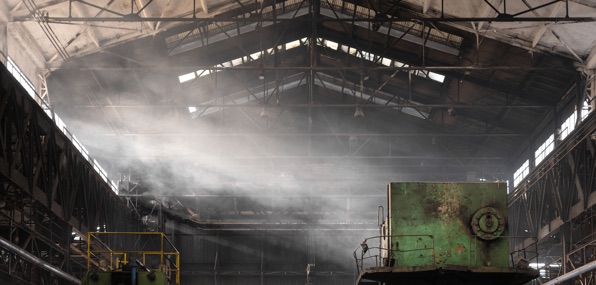
The ventilation system in the workshop must focus on the expulsion considering that the cloud of fumes in production, generally stagnates at a height between 4 and 7 meters above ground.

– During winter, doors and windows are closed, resulting in smoke stagnation with poor ventilation and air exchange.
– During summer or intermediate seasons, the ventilation problem is partially solved by opening doors, gates and windows, even if this is not possible at night or in case of rain.
Let’s start with the regulatory references
The Legislative Decree of 9 April 2008, known as Law 81, in Annex IV point 2.1.9.1 clearly states that in premises or workplaces or in transit must be, as far as technically possible, the formation of dangerous or noxious concentrations of gases, exploding vapours or dusts, flammable, asphyxiating or toxic, shall be prevented or minimised; where necessary, adequate ventilation must be provided to avoid such concentrations.
What are the objectives of general ventilation in production
Leaving aside offices or other premises, we want to focus on welding, grinding, painting or where fumes and dust are produced in high quantities. In this case the ventilation system must concentrate on the expulsion of stagnant fumes, assuming that the cloud of fumes in production, generally stagnates at a height between 4 and 7 meters from the ground.
Obviously the air flow helps to normalize the temperature during the heating periods, avoiding that the hot air stagnates at the top, with consequent benefits not only for the fumes but also to improve the microclimate in the workshop.
The national reference legislation, DPR No. 303/56 on workplace hygiene, does not clearly state whether or not air circulation in the workplace is possible.
For sure in order to aspirate, filter and recirculate the air inside a workshop where there are fumes and dust is necessary to carry out a remediation project that uses the best available technologies and in any case it is not possible to recirculate in case there are very toxic pollutants.
The project involves the ventilation of the rooms with aspiration and expulsion outside of the fumes and stagnant dust, carried out through wall fans or roof extractors, with switching on and off automatically controlled by the AIRTRACKER system.
How it works
Thanks to AIRTRACKER it is possible to monitor in real time the main environmental parameters of the air in the workshop and consequently to operate the ventilation only when necessary through a Wifi controller that must be simply connected to the electric control panel fans.
Why “smart”
– Safe for workers, it is always activated in case of smoke.
– Also effective for summer ventilation, with room temperature control.
– Applicable in any business context to existing ventilation systems.
In terms of design, professionals usually consider:
The spare parts/hour are the most used for the ventilation of industrial production environments, buildings, workshops, and factories. They represent a specific flow per cubic meter, in practice it is necessary to multiply the volume of the environment for the number of spare parts/hour desired, so as to obtain the flow in x thousand m3/h required to the plant.
Once the overall flow rate has been achieved:
Normally in industrial production environments we range from a minimum of 6/10 spare parts/hour up to 20 spare parts/hour of foundries.
Installed on the wall or ceiling, upon reaching the maximum set value of fine dust and fumes in the air (adjustable between 0 mg/m3 to 15 mg/m3) automatically starts the forced ventilation of the room, allowing you to expel smoke and welding dust, grinding or other pollutants outside, and then turn off the fans once the dust level has returned to the threshold required by regulations, saving energy.
Dust Detection Sensor
A LED bar with traffic light function indicates the current status of the concentration of fine dust in ambient air.
By means of any device with Internet functionality (smartphone, tablet, PC) you can connect with the Airtracker via Wi-Fi or LAN.
The 3 potential-free locking contacts can be used for the integration of fans or similar equipment. The relays are also connected to the bar.
Fill in the form below to request a quote by email, agree on special conditions, or technical clarifications